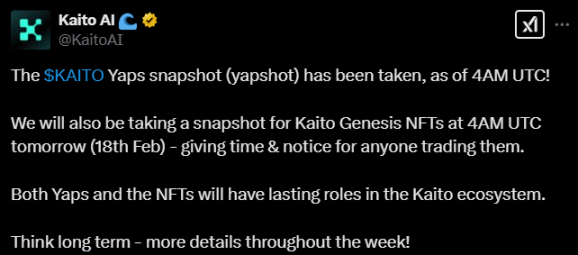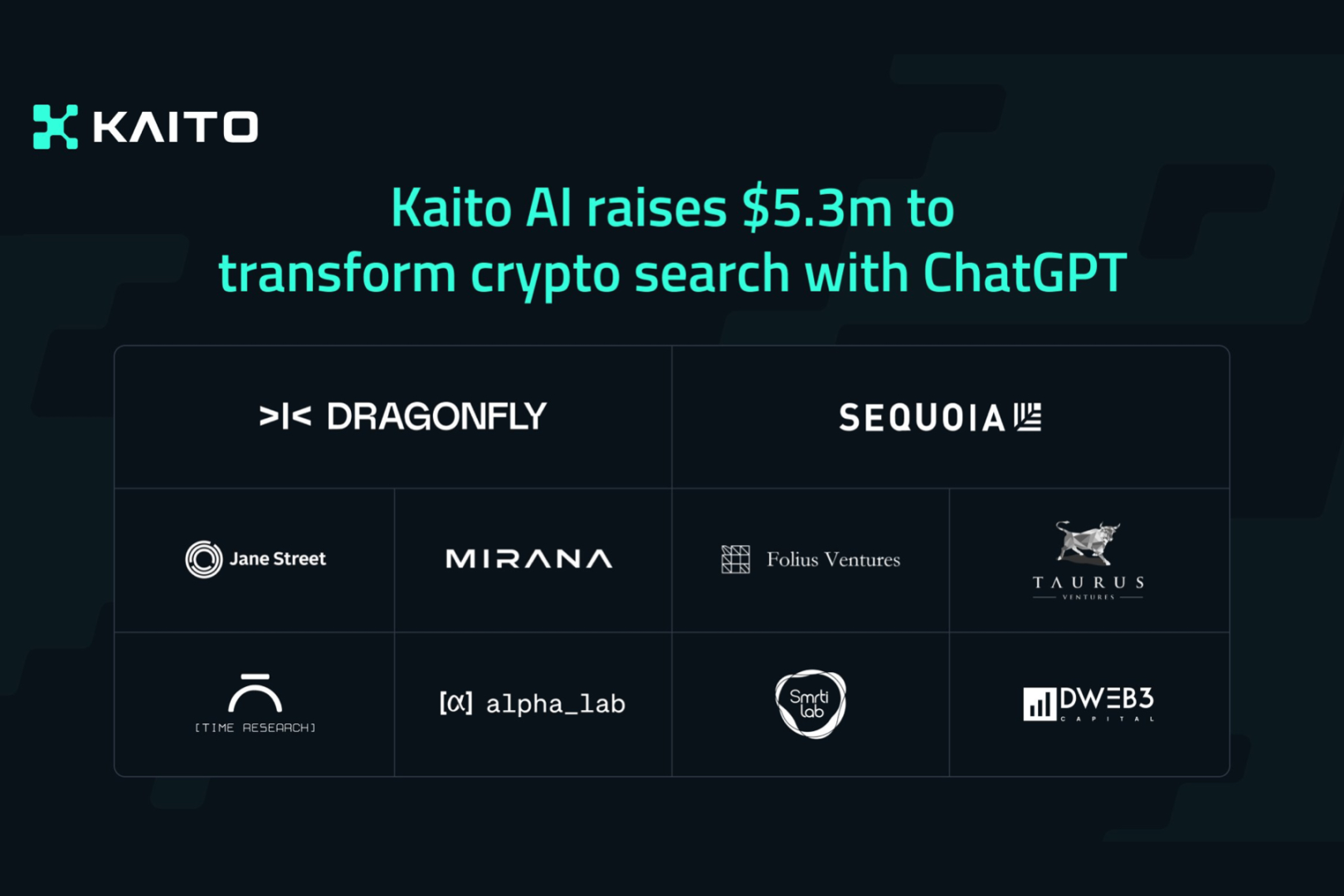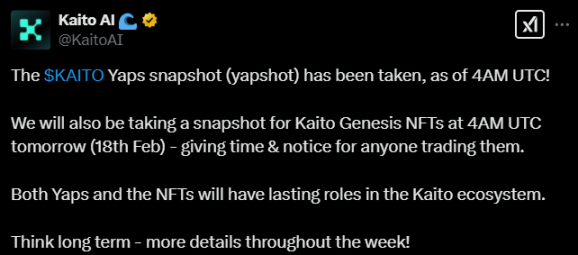Author: Luke, Mars Finance
introduction
On February 17, Kaito AI, an AI-powered Web3 search engine, announced the completion of the KAITO Yaps snapshot, followed by the Genesis NFT snapshot. In this long-planned wealth distribution, on-chain analyst Caneleo found that Kaito has deployed 1 billion tokens on the Base chain, of which 33.3% may be used for airdrops.

In other words, there are 333 million $KAITO on the market that will be distributed to NFT holders and Yap contributors. Based on Kaito's last round of financing valuation of $87.5 million, and calculated at a 33.3% airdrop ratio, the theoretical total airdrop value is close to $28.875 million.
Among them, Kaito designed a two-tier airdrop system:
- Genesis NFT holders: 1,500 NFTs will be allocated 15% of the airdrop pool (approximately $4.32 million), and each NFT is expected to receive $2,880 in $KAITO;
- Yap contributors: The remaining 85% ($24.555 million) will be distributed in proportion to the points. Combined with the current release rate, the value of each Yap is approximately $13.
When the market realized the scale and return rate of this airdrop, FOMO sentiment quickly heated up. Various "money-grabbing" armies sprinted frantically to the leaderboard, Kaito's tweets were flooded on X (original Twitter), and a Web3 version of the "Airdrop Hunger Games" officially kicked off.
Why has Kaito quickly become the most watched airdrop project in Web3 after EigenLayer?
Valuation expectations ignite FOMO: Kaito was valued at $87.5 million in its Series A round in June 2023. Compared with Berachain, its valuation increased 8 times after financing. If Kaito follows the same route, the airdrop value may be magnified 10 times.
Ecological leverage amplifies profits: Kaito adopts a dual points system of "Yap to Earn" + "Genesis NFT". Users holding NFTs may even receive airdrop rewards of over US$13,000.
Support from top venture capital firms: Sequoia Capital, Dragonfly and other institutions have entered the market, strengthening project endorsement and greatly increasing market confidence.
In the atmosphere of FOMO, Kaito is not only an AI search engine, but also a Web3 wealth-creating volcano that is about to erupt.
Who is Kaito? — The “AI Rainmaker” of the Web3 Information Empire
If EigenLayer is the hottest "liquidity re-staking" project this year, then Kaito is a pioneer in the field of information finance (InfoFi), and its goal is to become the Google + Bloomberg terminal of the crypto world.
Kaito was founded by Yu Hu, a former quantitative trader at Citadel, and is focused on solving the problem of information fragmentation in the Web3 world. Faced with massive amounts of scattered data from Twitter, Discord, governance forums, etc., Kaito integrates them through AI big models to create MetaSearch, an intelligent search engine tailored for crypto investors.
Unlike traditional search engines, Kaito can not only index various Web3 data sources, but also generate in-depth analysis in combination with ChatGPT technology, allowing investors to obtain market intelligence with one click and accurately capture Alpha opportunities on the chain. Therefore, Kaito is also called the "Web3 version of Alpha Catcher".

In the past two years, Kaito has performed well in the capital market and attracted the attention of top venture capital firms:
- Seed round (February 2023): Led by Dragonfly, it raised $5.3 million at a valuation of $40 million.
- Series A (June 2023): Led by Superscrypt and Spartan, it raised $5.5 million and its valuation soared to $87.5 million.
- Growth inflection point (June 2024): Kaito announces its first profitability, transforming from a “cash-burning startup” to a self-sustaining AI giant.
The investment from top venture capital firms not only means recognition of Kaito’s business model, but also further strengthens its ecological value and provides strong support for future token economic models.
Kaito is not just a search engine, it also builds a whole information economy system. Through the "Yap to Earn" model, users can earn Yap points in the following ways:
- Content Contribution: Share crypto market analysis by posting on Twitter and tagging @KaitoAI.
- Social fission: Invite friends to participate and use multi-account tools (such as MoreLogin) to improve the efficiency of obtaining points.
- NFT Empowerment: Holding Genesis NFT (minting price 0.1 ETH) can increase the airdrop weight and even have the opportunity to receive up to $13,000 in token rewards.
This mechanism converts information attention directly into on-chain assets, making Kaito not just a tool but a platform for "mining".
Valuation Game: The Value Code of the Airdrop Feast
In the Kaito airdrop carnival, Yap points and Genesis NFT became the focus of market attention, and the discussion around their value intensified. Multiple analysis models attempted to predict the reasonable valuation of Yap and NFT, and the conclusions under different assumptions also made market expectations gradually evolve from rational game to FOMO frenzy.
1. Fund-driven model: Theoretical extreme value derived from the FDV formula
Valuations in the crypto market have always been based on narratives and capital flows, so the first model directly starts from Kaito's future fully diluted valuation (FDV) and attempts to calculate Yap's potential value.
KOLRen_gmi uses the formula of FDV × airdrop ratio / total circulation, assuming:
- Kaito’s FDV is $1 billion;
- 30% of tokens are used for airdrops;
- The Yapper plan will run for 90 days, releasing a total of 2.275 million Yaps.
On this basis, the model calculated that Yap is worth $131, far exceeding mainstream market expectations.
But this deduction has obvious flaws:
- Additional NFT airdrops are not taken into account, which may affect Yapper’s actual earnings;
- The total supply assumption of Yap is too ideal, and the actual circulation may be affected by factors such as listing on exchanges and the pace of issuance by project parties.
Nevertheless, the model still gives extreme values under the market's optimistic expectations, providing theoretical support for the attractiveness of Kaito's airdrop.
2. NFT Voting Rights Model: Game of Web3 Community Governance
Compared with the simple FDV derivation, KOLDeFiTeddy2020 adopts an NFT voting rights model that is more in line with the Kaito ecosystem.
In Kaito’s design, Genesis NFT gives holders a greater voice in ecosystem governance, and these NFTs also have airdrop weights. Therefore, the model assumes that:
- The market price of a single Genesis NFT is 9.3 ETH;
- The corresponding voting weight is 1162 Yaps;
Based on this calculation, the theoretical value of each Yap is approximately US$22.
This method starts from the market pricing of NFT and attempts to establish a relative valuation relationship between Yap and NFT, but its limitations are:
- ETH price volatility risk: the market price of NFT itself may be affected by liquidity;
- The weight of voting rights does not necessarily directly reflect the value of tokens, and the way governance power is assigned is still not completely transparent.
Although the value obtained by this model is much lower than the FDV derivation method, it provides a new perspective to understand Yap's valuation from the perspective of NFT ecology.
3. Competitive Benchmarking Model: Comparability between Kaito and Hyperliquid
In the Web3 track, valuation often depends on the market's benchmarking of similar projects. KOLSteve_4P used a competitive product comparison method to compare Kaito and Hyperliquid, trying to come up with a valuation range that is more in line with market logic.
From a PMF (Product Market Fit) perspective:
- Hyperliquid: Based on the mature decentralized exchange (DEX) model, it optimizes the verified trading market;
- Kaito: Exploring a new paradigm of information finance (InfoFi), but a stable market demand closed loop has not yet been formed.
In terms of comparable valuations:
- Hyperliquid can be compared with DEX such as dYdX and Drift, and the market recognition is relatively clear;
- Kaito currently has no direct competitors. The closest example may be Friend.tech, but the latter's social finance model has major flaws.
From the perspective of token value capture:
- Hyperliquid has a clear token destruction mechanism to help maintain long-term value;
- Kaito’s revenue distribution mechanism has not yet been closed, and the value of its tokens is still highly uncertain.
Based on these factors, the model assumes that Kaito token returns are not expected to exceed Hyperliquid, so Yap’s valuation ceiling may be much lower than some of the market’s extreme predictions.
4. Realistic valuation model: deriving market expectations based on financing data
Compared with theoretical deduction, the market prefers real data support. Kaito's Series A financing valuation is 87.5 million US dollars. Combined with the announced 33.3% token airdrop plan, we can deduce a more reasonable value range:
- NFT valuation derivation: The total cost of 1,500 Genesis NFTs is $540,000. Based on the financing valuation magnified 8 times, the total airdrop is expected to be approximately $4.32 million, and each NFT is approximately $2,880;
- Yap Points Valuation Derivation: The remaining $24.555 million will be distributed to Yap Points holders. Based on the current release rate, 1 Yap is worth approximately $13.
However, financing valuation is not the final market price, so the model further uses Story Protocol and Berachain as benchmarks to derive a reasonable market range:
- Story Protocol: The valuation has been magnified 16 times, and the current FDV is about 1.73 billion US dollars. According to its market performance, Kaito's NFT may be worth 2218-2880 US dollars in airdrops, and Yap is worth 10-13 US dollars.
- Berachain: The financing valuation has been magnified 8 times, and the current FDV is about 2.8 billion US dollars. If Kaito follows the same path, the NFT airdrop may be worth 5,357 US dollars, and Yap is worth 24 US dollars.
Under the extreme FOMO sentiment in the market, Berachain's highest FDV once reached 6.75 billion US dollars. If Kaito replicates this model, its NFT may soar to 13,000 US dollars and Yap's value may reach 59 US dollars.
Conclusion: Valuation volatility and market frenzy
From the above four models, we can see the different possibilities of Kaito airdrop value:

Ultimately, the actual value of the Kaito airdrop will depend on the following key factors:
- Market feedback after the token is launched: If liquidity is sufficient, the valuation may rise significantly;
- The long-term development strategy of the project: If the InfoFi ecosystem can be closed, the value captured by the token will be more stable;
- The evolution of market sentiment: The duration of the FOMO atmosphere will affect short-term value fluctuations.
What is certain is that Kaito is creating a new airdrop storm in the crypto market, and how this storm will end still needs the market to give the answer itself.













